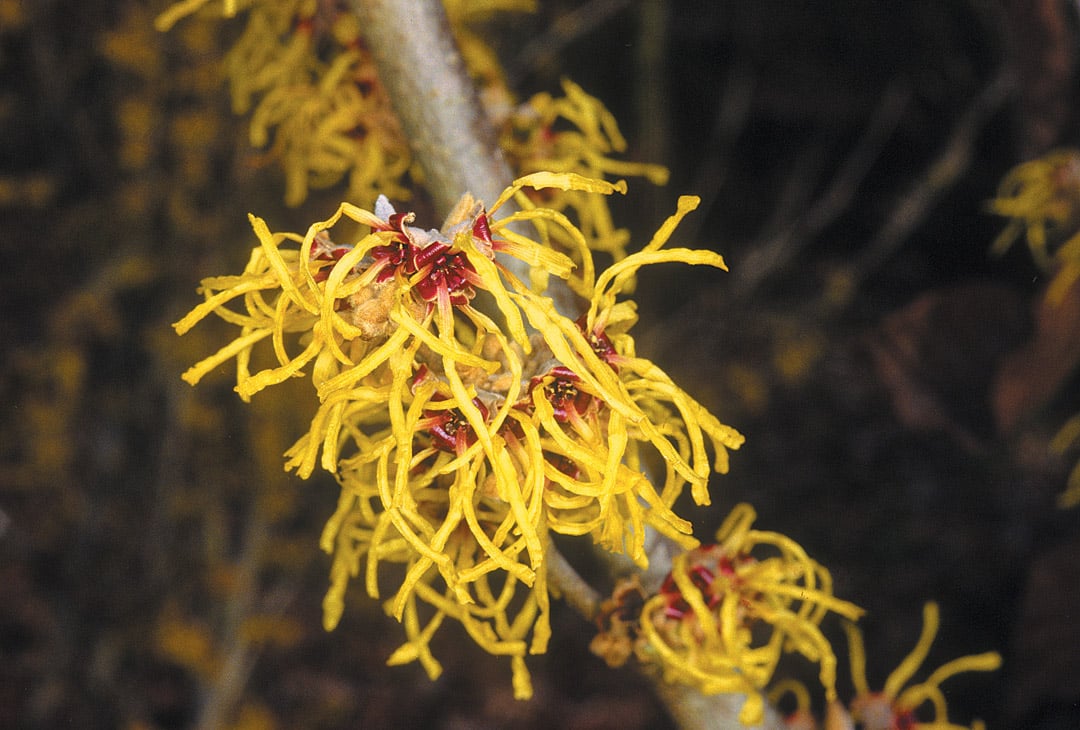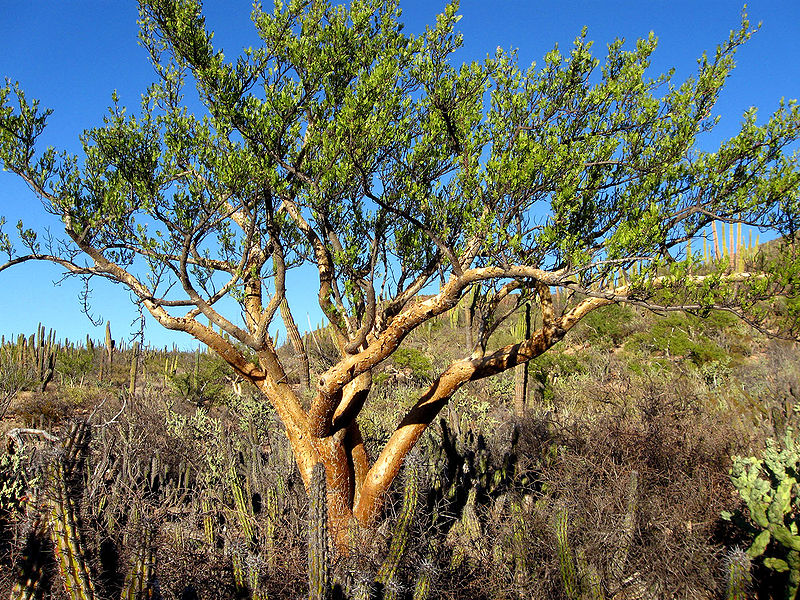

Contributor
- Topics: Archive, Plants You Need

Imagine walking into your garden on a frosty midwinter morning. The sun is just peeking through the overhanging branches of a magnolia. You come across a small tree, barren of leaves but possessing a great multitude of curious golden yellow tufts. As the sun illuminates these tiny fists, suddenly wispy fingers unfurl in response to the new warmth: the shrub’s spidery flowers burst forth along the branches like tiny sulfur flames. Then your olfactory senses are treated to an intoxicating citrus scent. A smile crosses your face. Just maybe, you think, immersed in the sublime winter luminosity of a witch hazel, spring is not that far off.
What distinguishes witch hazels in the plant world is that flowers, fruits, and next year’s leaf buds can manifest simultaneously on the plants; indeed, the generic name Hamamelis translates as “together with fruit.” Some witch hazels put on a fall color show, their foliage aging from butter yellow to orange, finally turning scarlet before falling exhausted to the ground. The climax to this show comes with the fruit: two-parted capsules, each about a half inch long and containing a single glossy black seed, split open with such explosive force that seeds land as much as thirty feet away.
The sheer diversity, beauty, and all-season appeal of witch hazels have put them near the top of the list of valuable garden shrubs. Although witch hazel cultivars, especially those derived from the two American species, are more common on the East Coast, they have become increasingly popular among West Coast landscape professionals. As has been the case with other genera, this rise in popularity has resulted from the successful introduction of hybrid selections.
A Japanese Species
The genus Hamamelis is comprised of four species, two native to the United States and one each from China and Japan. Japanese witch hazel (Hamamelis japonica) was first introduced to Europe by Philipp Franz von Siebold, a German doctor and naturalist. Joining the Dutch East India Company as a physician naturalist, he made his first trip to Japan in 1822. His status as a doctor gave him rare access to the country and allowed him to collect many indigenous plants, including H. japonica. Though he described the species in his 1843 publication Florae Japonicae, it was not until 1863 that he offered it for sale in the Netherlands.
The Japanese name for witch hazel is mansaku, translated as “rich crop” in reference to folklore that posited that, when flowers appeared in great number, abundant crop harvests would follow. The name has also been translated as “earliest flowering” and “early in the valley.” Japanese villagers use the flexible branches to make rafts, baskets, and shelves. Flowers are prized in traditional tea ceremonies. Japanese witch hazel is similar in appearance to an American species (H. virginiana), but has larger flowers and shorter fruiting calyxes.

The introduction of Chinese witch hazel (Hamamelis mollis) to the West followed a bit more tortuous path. Charles Maries, employed by the nursery firm of Charles Veitch & Sons in London, was sent to China in 1877 to collect interesting native plants. He returned from the Lushan Mountains with seed of this species but succeeded in raising only one plant. Twenty years passed before George Nicholson, curator at Kew Gardens in London, determined that this plant was different from the recently acquired Japanese witch hazel. It was not until 1914 that Arnold Arboretum in Massachusetts began distributing seed, plants, and graft wood to individuals and nurseries.
Despite those tribulations, Chinese witch hazel cultivars have become more widely available in the US than those of its Japanese cousin. One reason is that, while both offer delightful yellow to golden blossoms, flowers of the Chinese species are the most fragrant of all the witch hazels. Some also consider it to be the prettiest, with elongated petals that have less of a twist than those of other species. Ranging in height from ten to twenty feet, its dark yellow flowers appear on bare stems from December to March.

Two from North America
Not surprisingly, the most popular American species, common witch hazel (Hamamelis virginiana), made its entry on the American scene much earlier, having been discovered in 1687 and grown in England by Bishop Henry Compton. Despite its species epithet, common witch hazel is found over a wide swath of the Eastern states, reaching as far west as Texas, and in Canada, from Ontario to Nova Scotia. This was the first plant to be called a witch hazel, a name derived from its resemblance to the European hazelnut (Corylus avellana), both in its leaves and in its use as a divining rod in the early days of the American colonies.[1. Christopher Lane Witch Hazels, 2005. Portland, OR: Timber Press.]
It is commonly found in moist woods and along streams, where it contributes to autumn’s show of color. “Amongst the crimson and yellow hues of the falling leaves, there is no more remarkable object than the witch hazel, in the moment of its parting with its foliage, putting forth a profusion of gaudy yellow blossoms, and giving to November the counterfeited appearance of spring.”[2. GB Emerson, quoted in Lane’s Witch Hazels]
Common witch hazel is preferred by some gardeners over other species because of its earlier flowering. Whereas the others are winter blooming, this one flowers in the fall, making it a wonderful addition to any garden’s autumn color palette.
Ozark witch hazel (Hamamelis vernalis) is limited in its distribution to the Ozark Plateau of Missouri, Oklahoma, Arkansas, and Louisiana. It displays an impressive range of flower color, from pale yellow to deep red or reddish purple, as well as fiery fall foliage. The color variation is sufficiently pronounced for some experts to assert that the species has suffered some genetic modification by surrounding stands of common witch hazel. Although Ozark witch hazel cultivars are not highly sought after because of the relatively small petals on the flowers, hybrids have recently been created between the two American species, offering hope of sturdy and colorful autumn blooming selections.
Medicinal Uses
Though Hamamelis virginiana had been known botanically for nearly two centuries, it was not until Thomas Dickinson built a witch hazel distillery in 1866 that the tree became commonly known for its medicinal value. Dickinson had acquired his knowledge, in part, from local Native American tribes, including the Cherokee and the Iroquois. They used a decoction of the plant, derived from boiling its twigs and small branches, to treat cuts, bruises, and other injuries. They also found it helpful with colds and, in salve form, as a balm for sore or injured eyes. The preparation of their “magic water” underwent little change when Dickinson began manufacturing it, being eighty-six percent double-distilled witch hazel extract and fourteen percent alcohol. That formula has continued to this day—surely one of the oldest medicinal preparations to have survived unchanged.

Intermediate Hybrids
The popularity of witch hazels jumped once the two Asian species were crossed to produce the sturdier Hamamelis xintermedia hybrids. Hybridization of these species had been going on since the 1930s at places like Arnold Arboretum and Denmark’s Charlottenlund Botanical Garden. The first to be named was ‘Arnold Promise’ in 1963, followed by ‘Diane’ in 1969. The mid-eighties brought a flood of new cultivars, signaling a renaissance in witch hazel popularity.
Popularity implies two conditions: cultivars that are varied and interesting, and plants that are disease resistant and reliable for the casual gardener. The new hybrid cultivars achieved these twin goals. Proof of the former can be seen by the number of hybrid cultivars now commercially available, in all shades of yellow, orange, and red, and in heights ranging from six feet to a towering twenty-five feet. Breeders have also been successful in producing hardy plants that are largely disease resistant.
A few of the more popular and commercially available witch hazel cultivars (derived from Hamamelis xintermedia, unless otherwise noted) are:
• ‘Arnold Promise’. Lemon yellow, sweetly fragrant flowers, appearing in late winter to early spring. Its autumn color, in shades of yellow, orange, and red, is unusual among yellow-flowered cultivars. A deservedly famous cultivar still in demand today. To ten feet tall.
• ‘Aurora’. Pale yellow flowers, with a warm orange base, appearing in midwinter. Has the longest petals of any cultivar, an excellent bouquet, and fiery autumn foliage. To ten feet tall.
• ‘Barmstedt Gold’. Long lasting, golden yellow flowers with a red base, appearing in late winter. Has a subtle scent. Highly rated by growers and witch hazel experts. To ten feet tall.
• H. mollis ‘Boskoop’. Golden yellow flowers with a red base. Blooms in early winter. The most widely distributed cultivar worldwide. Intensely fragrant. Yellow fall foliage. To ten feet tall.
• ‘Diane’. The deepest red flowers of any cultivar, appearing in midwinter. Named after the daughter of famed Belgian growers Robert and Jelena de Belder. Subtle fragrance. To eight feet tall.
• ‘Jelena’. Features luxurious copper flower colors, blooming in early to midwinter. One of the most popular of all witch hazels, notwithstanding its lack of scent. To twelve feet tall.
• H. mollis ‘Pallida’. Expert Chris Lane’s top pick among the yellows. Highly floriferous, with citrus- scented, sulfur yellow flowers. Easy to grow. Buttery fall foliage. To ten feet tall.
• ‘Rubin’. Flowers mature to a fabulous, clear red with a red purple calyx in midwinter. Lightly fragrant. Foliage ages to an orange gold in the fall. Highly rated. To twelve feet tall.
• ‘Westerstede’. Lovely primrose yellow flowers, elaborately curled and crimped. Blooms in late winter. Golden yellow fall foliage. Light scent. To ten feet tall.

Landscape Gems
Given the winter appeal of witch hazels, finding a good site is worth some time and thought. Though flower color and scent will figure prominently in your decision, the tree’s mature shape and winter silhouette should be carefully considered. The size of your garden, and the degree to which you wish to feature your selection, or blend it into a woodland garden, will help you decide which of the six basic shapes will best serve your needs.[3. Georgene A Bramlage, “Hamamelis—Landscape Aristocrats.” Suite101.com, December 4, 2006.]
• Upright. Several selections of Hamamelis virginiana and H. xintermedia can reach thirty feet tall and twenty feet wide.
• Vase-shaped. These include cultivars such as ‘Arnold Promise.’
• Oval/Rounded. These multi-stemmed specimens, including H. vernalis (to twenty feet tall) and H. mollis (to fifteen feet tall) cultivars, may become wider than taller.
• Spreading. Cultivars such as ‘Carmine Red’ are smaller (to ten feet) and wider (to fourteen feet) than others, but also quite vigorous.
• Horizontal Spreading. Certain H. japonica cultivars have an almost flat-top habit.
• Weeping. Much less common, there are selections such as ‘Lombart’s Weeping’ that are low (to four feet) and wide (to ten feet) and can be pruned to achieve a weeping habit.
When used as a feature plant, situate a witch hazel where a clear foreground will make its charms readily apparent. Ideally, this would be near a path or a sitting area. A background of evergreen shrubs will show off the witch hazel’s delicate and colorful blooms, especially the yellows. And, given their winter appeal, you might like to plant your witch hazel where it can be viewed from indoors.
In a woodland garden, consider the amount of sunlight that will reach your planting. Witch hazels are best under deciduous trees, which admit winter sunlight through their bare branches. Witch hazels shaded by evergreens tend to exhibit straggly growth and fewer flowers. Consider Japanese maples (Acer palmatum), Chinese pistache (Pistacia chinensis), or Loropetalum chinense ‘Razzleberri’ as companion plants for complementary fall color.
To create a varied winter garden, try adding shrubs such as Mahonia lomariifolia or Oregon grape (M. aquifolium), with their serrated, evergreen leaves and golden flowers. Viburnum tinus and Daphne odora are excellent choices for their evergreen foliage, and both contribute a heavenly floral scent in winter. For texture, include one of the shrubby dogwoods such as Cornus stolonifera; their attractive red or yellow bare stems will strengthen the winter color scheme.
Planting and Care
First and foremost, witch hazels need a winter chill to achieve full flowering. For best results, temperatures should drop to at least 30°F. Most of the species and cultivars are hardy down to -10°F (equivalent to USDA hardiness zone 5); common witch hazel will survive colder temperatures without harm. The Sunset Western Garden Book lists them as suitable for zones 3-7 and 15-17, although, again, common witch hazel will work in colder zones.
Plant in humus-rich soil, making sure that it receives proper drainage. Witch hazels grow happily in a pH range between 4.5 and 6.5. It is important to keep young plants growing well; if they suffer at an early stage, flowering will be reduced in both quantity and quality.
Witch hazels need summer water, especially to establish the root systems of younger plants. Mulching is beneficial in maintaining soil moisture. Young plants may need to be protected with horticultural cloth or Cloud Cover to avoid any damage during frosty spring nights, when the sap is rising.
As most cultivars are produced on grafted stock, make sure to prune off any suckers appearing below the graft line. Chris Lane also recommends yearly pruning after the tree has flowered; he prunes all of the previous season’s growth back to two growth buds to encourage the maximum flowering in the following season.
Modern Witches
A few minutes of internet searching on witch hazels will highlight just how far they have come as landscape plants in the last twenty years. There are now more than a hundred cultivars, with more than twenty established as mainstream choices. And why not? Witch hazels are like the band that has not gotten a major label deal but opens for the stars and surprises the audience with talent and charisma. With four-season appeal in both foliage and flower, witch hazels add a unique bouquet to the fragrant garden, and are a standout in the winter landscape.
The writer is indebted to Christopher Lane, one of the foremost authorities on the subject of witch hazels, for the historical information referenced in this article.
Share:
Social Media
Garden Futurist Podcast
Most Popular
Videos
Topics
Related Posts

Ground Up Science for Greener Cities with Garden Futurist Dr. Alessandro Ossola
Spring 2023 Listen to the Podcast here. Alessandro Ossola is a scientist who gets very excited about the challenge of climate change allowing for an

Readying Urban Forests for Climate Realities with Garden Futurist Dr. Greg McPherson
Winter 2023 Listen to the Podcast here. “Going from the mow and blow to a more horticulturally knowledgeable approach to maintaining the landscape. And that

Welcome, Greywater, to the Garden
Summer 2022 Oh, summer: delightful warm air, tomatoes swelling on the vine, fragrant blooms on an evening stroll. When it’s warm and rainless, how is

Big Tree-Data and Big-Tree Data with Garden Futurist Matt Ritter
Summer 2022 Listen to the full Garden Futurist: Episode XV podcast here. We are in an environmental crisis right now in many parts of California









Responses